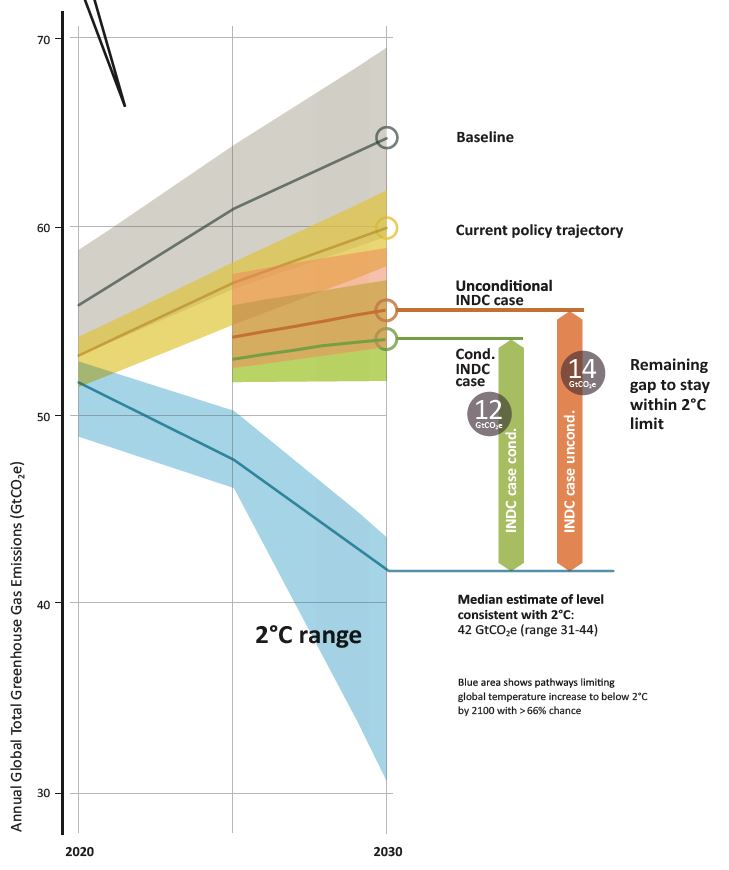Confronting the “Emissions Gap”
Long-term thinking and short-term deficiencies in climate change mitigation
With the Paris Agreement now ratified by 86 countries, and entering into force this Friday, countries have defined their first targets—the first round of nationally determined contributions (NDCs). The United States has pledged to reduce GHG emissions 26-28% below 2005 levels by 2025. This initial round of NDCs is significant, but represents only a short timeframe and a first step.
Since the 2009 Conference of the Parties in Copenhagen, the UNFCCC has reaffirmed a goal of limiting global temperature increases to 2ºC above pre-industrial levels (and, under the Paris Agreement, to work toward a 1.5ºC limit). As others have written, the commitments to date under the Paris framework are not sufficient to create even a reasonable chance of meeting the 2ºC target; according to UNEP, the NDCs leave a wide “emissions gap.”
Eventually, halting warming implies a long-term equilibrium: net-zero global GHG emissions. Getting to that long-term goal requires medium-term action as well—transition from the current, carbon-heavy energy system to a decarbonized system, where economic growth is no longer tied to fossil fuel consumption.
Based on the IPCC’s projections in its Fifth Assessment Report, for a trajectory reasonably likely to meet the 2ºC target, global GHG emissions need to be cut nearly in half (or more) by 2050; for wealthier, high-emissions countries, that generally means much steeper cuts to accommodate transitions elsewhere. As a rough guidepost, the United States’ position is that the country’s short-term commitments are “consistent with . . . deep, economy-wide emission reductions of 80% or more by 2050.” However, what the UNEP report shows (see figure below), is that even by 2030, the divergence between countries’ Paris commitments and that 2º pathway is clear. The longer we wait, the more catching up we’ll have to do.

What policies and actions, beyond “first steps” in the United States and elsewhere, would be consistent with a 2ºC target?
Earlier this month, UCLA hosted an interdisciplinary symposium on the environment, Earth Now: Earth 2050. During the event, UCLA’s Emmett Institute hosted a panel session, moderated by Professors Ann Carlson and Ted Parson, on US climate policy, geared toward medium- and long-term policies beyond “first steps” in climate mitigation. Panel speakers included Jim Williams, Director of the Deep Decarbonization Pathways Project (DDPP) (a joint initiative of the UN Sustainable Development Solutions Network and the Institute for Sustainable Development and International Relations, based in Paris); David Roberts, a reporter who covers energy and climate change issues for Vox; Congressman Ted Lieu, a Democrat whose district includes UCLA; and Philip Barnett, former Staff Director of the US House Energy and Commerce Committee.
Jim Williams presented findings from the DDPP’s US country report, first released in 2014. (Full technical and policy reports available here. David Roberts posted an analysis of the report at the time; Ann Carlson has also addressed it in an earlier Legal Planet post on the Paris COP.) Without getting too much into the details, the report is designed not as a forecast of US energy systems, but rather as a “backcast” with detailed, representative decarbonization scenarios for 2050, in an effort to demonstrate the feasibility of deep reductions in GHG emissions. The DDPP researchers built the scenarios around various constraints: avoiding premature retirement of infrastructure, maintaining electric reliability, consistency with forecasts for demand for energy services, reliance only on commercial or “near-commercial” technologies, etc. It includes four scenarios—a “high renewables” case, a “high nuclear” case, a “high CCS” (carbon capture and storage) case, and a “mixed” scenario, representing possibilities for emphasizing a variety of low-GHG electricity sources. All four scenarios include three “pillars” for energy system transformation: energy efficiency, decarbonization of electricity generation, and decarbonization of end-use energy.
The DDPP’s report, along with other models and decarbonization scenarios, provides a useful starting point for envisioning feasible energy transitions in the medium term; the challenge for those in the law and policy realm is translating that information into policy options that can effectively shape patterns of energy generation and consumption. That is, turning it into measures that can be enacted, implemented, and enforced within legal and political constraints. David Roberts’ remarks here at UCLA focused on the political economy of climate change—a reminder that before meaningful action can happen, we need to think about creating workable coalitions and constituencies that will provide ongoing support for new policy. Partisanship and polarization frustrate political dialogue—a phenomenon not unique, of course, to environmental issues—to an extent that comprehensive, long-term climate policy at a national level is difficult to envision.
But confronting the emissions gap conveys a sense that all policy options—all mitigation options consistent with deep reductions by the middle of the century—should be considered. Any such options that are available today—whether they focus on shifting energy generation, changing consumption patterns, promoting development with reduced energy or transportation needs, or limiting extraction of new fossil fuel resources, and whether they can be taken nationally or locally—should be taken urgently.
Reader Comments
4 Replies to “Confronting the “Emissions Gap””
Comments are closed.







“….What policies and actions, beyond “first steps” in the United States and elsewhere, would be consistent with a 2ºC target?…”
Answer: none. The 2ºC target is imaginary and misleading, it cannot be implemented because current technology limitations along with global social conditions prevent and do not facilitate achievement of this target.
Prof. Bryner, in 2006, CALIFORNIA Magazine published a Global Warning special issue cover story “Can we adapt in time?” that quoted leading evolutionary biologists who have concluded our brain is not designed for long-term thinking and actions that will protect the human race from self-destruction by global warming.
http://alumni.berkeley.edu/california-magazine/september-october-2006-global-warning/can-we-adapt-time
It is now 2016, atmospheric CO2 is now exponentially exceeding 400 ppm, and we have not begun to produce and implement actions yet.
Even more tragically, we had the opportunity to prevent this self-destruction during the 20th century when, according to Edward Teller in the 1960s, we could have designed and built fusion energy production plants, but human politics and greed prevented us from overcoming our brain limitations.
“….Prof. Bryner in 2006 asked “Can we adapt in time?…..”
Dear Prof Bryner and Anthony St. John
We believe there is plenty of good time to adapt and most people will adapt slowly and without much effort. Many of us have already adapted to climate change and will continue to do so as the need arises. Adaptation is not difficult nor particularly interesting. It is a personal commitment, most of us quietly adapt without mentioning it to others. No one else can do it for you.
I offer my education, experience and insight to encourage the general public to adapt and not worry about climate change. Do not waste precious time and resources on even more failures and futile schemes that purport to mitigate the global climate.
BQRQ, we have no international environmental leader to motivate people to fight back against global warming in time, so you’ll get your wish by default.
Churchill and FDR motivated us to win WWII, but there are no such leaders today in a world where our current political and intellectual institutions fail to protect the long-term future of the human race because evolutionary biologists are right.